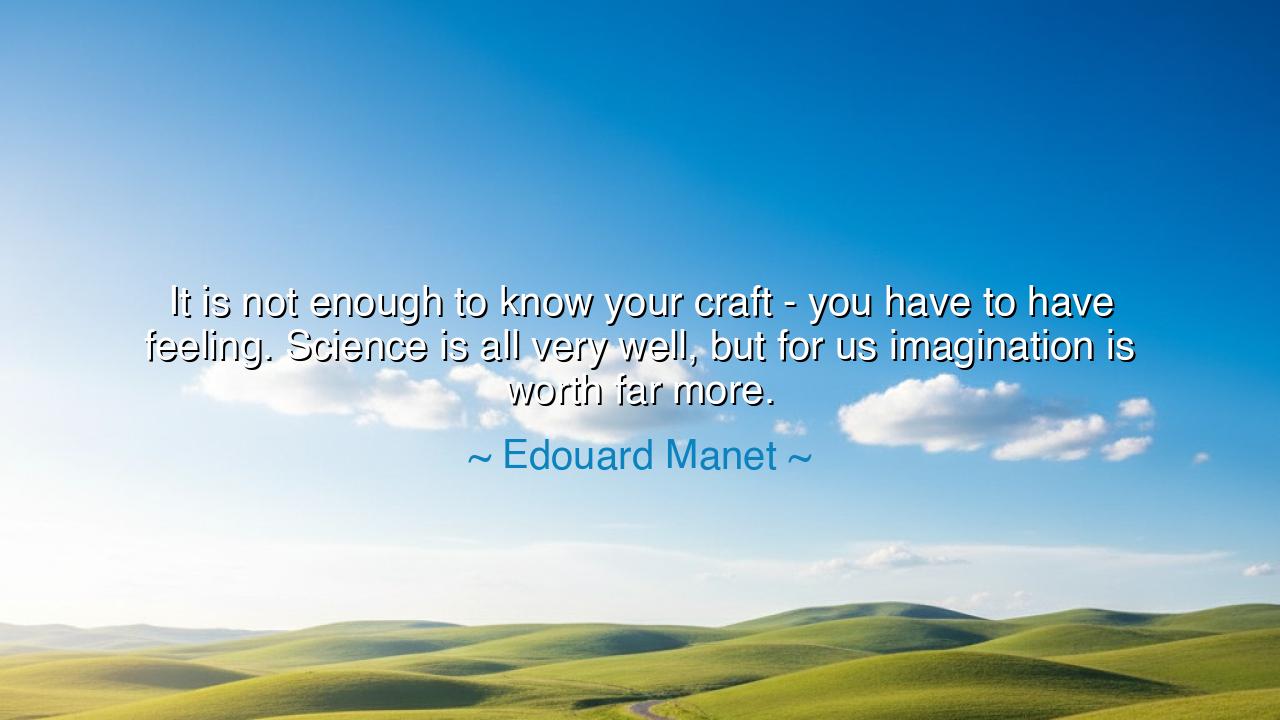
It is not enough to know your craft - you have to have feeling.
It is not enough to know your craft - you have to have feeling. Science is all very well, but for us imagination is worth far more.






"It is not enough to know your craft - you have to have feeling. Science is all very well, but for us imagination is worth far more." These words from Edouard Manet, the great French painter of the 19th century, remind us of the essential harmony between knowledge and creativity. In this assertion, Manet challenges the notion that mastery of technique alone is sufficient for true artistry. While science—or any craft, for that matter—provides us with the necessary tools and structures, it is imagination, the deep well of human emotion and intuition, that gives our work its soul. It is a reminder that without feeling, without vision, the most skillful execution of technique remains lifeless, like a machine devoid of purpose or inspiration.
In the ancient world, the great philosophers and artists understood the deep connection between reason and imagination. Plato believed in the philosopher-king, who must possess not only wisdom but also the capacity for vision and imagination in order to rule wisely. Similarly, Aristotle understood that creativity—whether in art, science, or philosophy—was not just a mechanical process of following rules, but an act of expression, a way of reaching deeper truths. The greatest thinkers of the ancient world did not merely record the facts, but imagined how the world could be understood in new ways. They fused rational thought with the creative power of the mind, blending science and imagination to shape the future.
Manet's words echo this ancient wisdom, particularly in the realm of art. During his time, he was a revolutionary figure in the art world, challenging the conventions of academic painting and embracing a new style of impressionism. For Manet, imagination was the driving force behind his paintings, more so than adherence to the rigid techniques of classical art. The Impressionist movement, which he helped pioneer, was not just about capturing reality with precision, but about translating the artist's feeling and perception of the world onto the canvas. It was an approach that emphasized emotion over detail, and in doing so, it liberated artists from the confines of traditional techniques and allowed them to express the world in vibrant, dynamic ways.
Think of Vincent van Gogh, another painter of that era, whose imagination and emotional depth transformed the art world. Van Gogh’s brushstrokes were filled with raw, intense feeling, more than just the desire to capture a scene. His iconic work, Starry Night, is not merely a depiction of a night sky—it is an explosion of emotion, a reflection of his inner turmoil and awe at the vastness of the universe. In his world, science—the ability to depict the world with exactitude—was secondary to the need to pour feeling and vision into every stroke. Like Manet, van Gogh believed that without imagination, the craft of painting was devoid of meaning, for it was imagination that gave the work its power.
But this lesson does not apply to art alone. In every craft, whether it is science, music, or literature, there must be a marriage between knowledge and feeling. The greatest scientific discoveries, those that have shaped the course of human history, often came from the ability to imagine what could not yet be seen. Consider the work of Albert Einstein. His theory of relativity did not emerge solely from the application of mathematical formulas, but from a vision—an imaginative leap—about the nature of time and space. Einstein’s imagination allowed him to see the universe in a way that others could not, transforming theoretical physics and leading to breakthroughs that reshaped our understanding of the world.
The lesson here is simple yet profound: craft alone is not enough. Whether in art, science, or life, we must cultivate both the technical skills and the imaginative spirit to create something truly impactful. Manet teaches us that imagination is what brings the world to life; it is the spark that transforms the ordinary into the extraordinary. Without imagination, we may have skill and knowledge, but we lack the ability to see the world in new ways, to push the boundaries of what is possible, and to create works that resonate with the soul.
In your own life, whether you are a scientist, an artist, or someone simply seeking to make a difference, do not allow your craft to become a mechanical exercise in rote knowledge. Yes, knowledge is essential—it forms the foundation upon which we build our understanding and our work. But remember that feeling, imagination, and vision are the forces that push us beyond what is known and into the realm of the unknown. Let your work be guided not just by the tools at your disposal, but by the creativity and imagination that stir within you. It is through this fusion of skill and vision that true greatness is achieved, whether you are painting on a canvas, exploring the depths of space, or writing the words that will one day change the world.
So, let us embrace the wisdom of Edouard Manet. Let us cultivate not only our technical abilities but also our capacity to dream, to imagine, and to create. It is through this union of craft and feeling that we will find the courage to change the world, to break the boundaries of the possible, and to craft a future filled with the light of inspiration and wonder.






AAdministratorAdministrator
Welcome, honored guests. Please leave a comment, we will respond soon